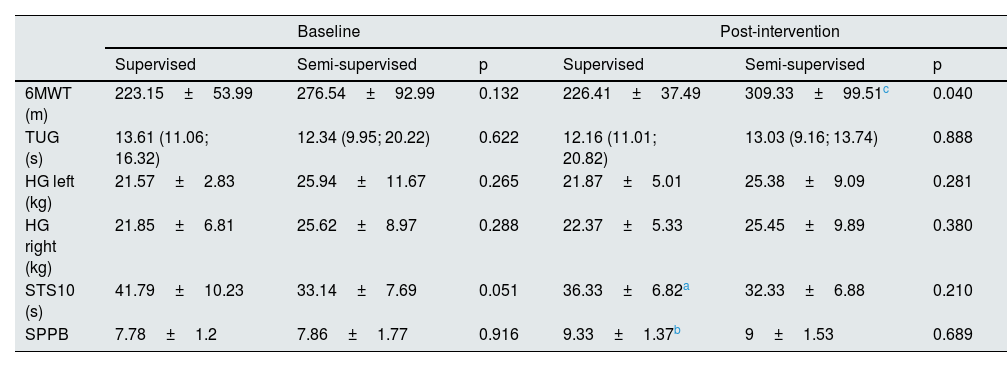Physical exercise during haemodialysis (HD) sessions has a positive impact on patients' functional capacity.1 However, this strategy is not widespread, among other factors, due to the financial cost of hiring staff to supervise them.2 One possible solution would be the development of semi-supervised programmes, which would reduce the need for constant presence of an exercise professional and therefore reduce costs. We present the results of an uncontrolled comparative study on the effects of a semi-supervised intradialytic physical exercise programme on functional capacity in patients on HD.
The patients, recruited from two centres located in southern Galicia, met the following inclusion criteria: (a) having chronic kidney disease (CKD) and having been on HD treatment for at least three months; (b) stable clinical status and adequate dialysis (ktv ≥1.3) for the last three months; (c) anaemia under control within normal CKD parameters (10.5−12g/dl); (d) having functioning vascular access. Exclusion criteria were: (a) having had a cardiac event in the last six months; (b) having had a stroke in the last six months; (c) having uncontrolled blood pressure; (d) having a left ventricular ejection fraction (LVEF) of 35% or less; (e) having episodes of hypoglycaemia at 60mg/dl or below. The study design was approved by the Ethics Committee of the Faculty of Education and Sport Sciences, Universidad de Vigo.
Two exercise programmes, supervised (SP) and semi-supervised (SS), were randomly assigned to each of the two HD units, involving three 40-min training sessions per week (first session aerobic, the other two focused on muscle strength development) for 12 weeks. In the SP group, all sessions were supervised, while in the SS group only the first session of each week was supervised. The effects of the programme on the patients' functional capacity were determined by the application of the "Six-minute walk test" (6MWT), "Handgrip test" (HG), "10-Sit-to-stand test" (STS10), "Timed up and Go test" (TUG) and "Short Physical Performance Battery" (SPPB), one week before and one week after the intervention.
For comparison between the two groups, we used Fisher's exact test for qualitative variables, and Student's t-test or Mann–Whitney U test for quantitative variables. For the pre-post intragroup comparison, we also used Student’s t-test for related data or the Wilcoxon rank test.
Out of a total of 36 participants, 11 patients in the SP group and 10 in the SS group completed the study (Table 1). After the intervention, significant changes were found in the STS10 and SPPB tests in the SP group and in the 6MWT in the SS group. In comparisons between the two groups post-intervention, there was only a difference in 6MWT in favour of the SS group (Table 2).
Comparison in physical tests in both groups, before and after the intervention.
| Baseline | Post-intervention | |||||
|---|---|---|---|---|---|---|
| Supervised | Semi-supervised | p | Supervised | Semi-supervised | p | |
| 6MWT (m) | 223.15±53.99 | 276.54±92.99 | 0.132 | 226.41±37.49 | 309.33±99.51c | 0.040 |
| TUG (s) | 13.61 (11.06; 16.32) | 12.34 (9.95; 20.22) | 0.622 | 12.16 (11.01; 20.82) | 13.03 (9.16; 13.74) | 0.888 |
| HG left (kg) | 21.57±2.83 | 25.94±11.67 | 0.265 | 21.87±5.01 | 25.38±9.09 | 0.281 |
| HG right (kg) | 21.85±6.81 | 25.62±8.97 | 0.288 | 22.37±5.33 | 25.45±9.89 | 0.380 |
| STS10 (s) | 41.79±10.23 | 33.14±7.69 | 0.051 | 36.33±6.82a | 32.33±6.88 | 0.210 |
| SPPB | 7.78±1.2 | 7.86±1.77 | 0.916 | 9.33±1.37b | 9±1.53 | 0.689 |
6MWT: Six-minute walk test; TUG: Timed up and Go test; HG: Handgrip test; STS10: 10-Sit-to-stand test; SPPB: Short Physical Performance Battery.
The physical exercise programme developed was based on a combination of aerobic and muscular strength-endurance activities, an approach found to have positive effects on functional capacity in patients on HD,3 although the results obtained were somewhat contrary to expectations. Patients in the supervised programme experienced improvements in their strength levels, but not in their cardiorespiratory fitness, contrary to what was found after other similar interventions.4 Notably, we also found improvements in agility and balance in the supervised programme, an effect of intradialytic exercise previously reported in the literature.5
We found no studies on the effects of semi-supervised intradialytic exercise, although the efficacy of semi-supervision has been analysed in patients on HD who were encouraged to do combined exercise at home. In that respect, Ortega-Pérez de Villar et al.6 found no significant changes in any of the variables we included in our study. These results show that prescribed semi-supervised intradialytic exercise appears to be more effective than home-based exercise, at least in terms of its effect on cardiorespiratory efficiency. In summary, our study suggests that the prescribing of semi-supervised exercise in HD units is feasible. However, the impact on functional capacity of such a programme differs from that of a fully supervised protocol and calls into question its effectiveness. The lack of randomisation of participants and the small sample size mean that these results need to be interpreted with caution.
FundingNo funding was received for this study.
Conflicts of interestThe authors have no conflicts of interest to declare.
The authors of this study would like to thank the Fundación Renal Íñigo Álvarez de Toledo [Íñigo Álvarez de Toledo Renal Foundation] for their collaboration in this research.







